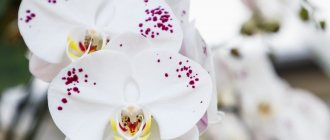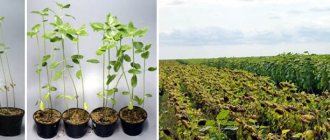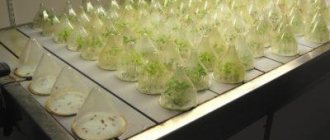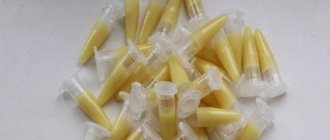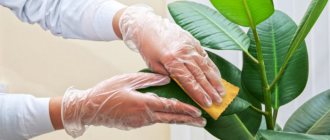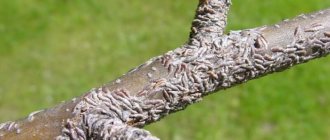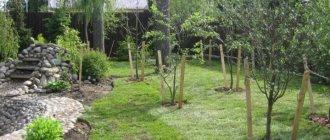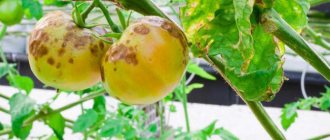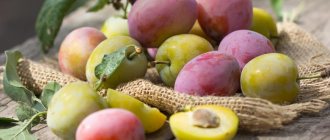Category: Pesticides Reading time: 9 min · Views: 5,517
Being a poison for insects, any drug used to combat them will, to one degree or another, be poison for humans - the only question is the dose. The drug Aktara (Switzerland) in this regard behaves in the same way as many others similar to it. By influencing some function of the insect’s body (in the case of Aktara, its digestive system), the product causes a chain reaction of shutting down all other body systems, which causes the death of the parasite.
But the balance of “pros” and “cons” of an action is determined not only by the toxicity indicator. This is also the cost of the drug, and ease of use, and its ability to maintain “killing power” for the next generations of pests, and the ways it affects them.
Composition and principle of action
The active ingredient of the drug is thiamethoxam. In small doses, the synthetic compound causes stimulation of the nervous system of pests. Significant concentration leads to paralysis. Aktara belongs to the group of contact-intestinal insecticides. The substance is absorbed into the plant tissue, along with the cell sap enters the gastrointestinal tract of the insect and provokes its death. Pests with thin cover die after contact with the drug. Actara's effect does not apply to eggs, pupae and larvae.
The insecticide is used in 2 ways: spraying the ground parts of garden, vegetable and indoor crops and watering at the roots. In the first case, the solution is absorbed by the shoots in a matter of minutes. When applied to the soil, it takes several hours for the active substance to be distributed throughout all the vascular tissues of the plant. For fruit trees, this time is on average 1-3 days; for low-growing crops, 2-3 hours are enough.
Thiamethoxam mainly accumulates in plant leaves; its concentration in fruits is insignificant. The protective function of the drug lasts for 2-3 weeks after foliar treatment and 2.5-3 months after watering the soil.
Description of the drug
When purchasing Aktara, you should pay attention to its chemical and physical properties. The substance is powdery and has a light cream color. There is no smell. Crystal shape. The drug is used exclusively in agriculture.
The class is neonicotinoids, but according to the method of application it belongs more to intestinal insecticides. Promotes flowering. At the same time, when used, gardeners can be confident in:
- absence of barren flowers;
- improving the seed;
- etching from parasitic microorganisms.
Application options: spraying, seeding application and watering. It has a wide spectrum of activity and translaminar effect. Therefore, it belongs to complex preparations. The instructions repeatedly emphasize that the insecticide simultaneously solves 85% of the problems that are possible in the garden plot.
Thanks to the perfectly selected composition, the substance is absorbed into the plant juice. Absorption occurs through all parts:
- roots;
- leaves;
- trunk, inflorescences.
Biological activity at a high level, which allows rapid inhibition (elimination of insects). The main component is thiamethoxam. This substance leaves no chance for pathogens and parasitic insects.
Interesting fact! Aktara does not contribute to the appearance of such a residual phenomenon as the presence of pesticides. In this case, the insect dies within a quarter of an hour. During this period of time, the most tenacious substances (aphids and whiteflies) experience the first symptoms of poisoning and stop feeding on plant sap.
Scope of application
The insecticide packaging shows a close-up picture of the Colorado potato beetle, a well-known enemy of potato beds. Despite this, the spectrum of action of the chemical is much wider. Aktara is used in the fight against aphids, whiteflies, thrips, scale insects and many other harmful insects. The effectiveness of protection against onion flies, cabbage flea beetles, and apple moths has been proven. Dangerous pests are controlled in several ways:
- spraying over the entire surface of the above-ground parts of plants;
- application to the soil in beds and in bowls with potted plants;
- soaking the roots of vegetable seedlings;
- treatment of tubers before planting in the ground.
Feedback on using Aktara
- Angelina, St. Petersburg: “I am an experienced gardener, and if earlier there were only phalaenopsis on my windowsill, today they have almost been replaced by cattleyas, cymbidiums, cambria and even one carrot (catasetum). “Everything has happened over these 13 years, but Aktara has always saved me, so don’t be afraid of these scale insects and thrips - everything can be treated, unlike bacterial rot, which affects plants from time to time.”
- Alexander, Stavropol: “We go to the dacha, like a resort, with great pleasure. Barbecue, gazebo, long conversations in the apple orchard, but also potatoes, where would we be without them. Previously, the harvest was poorer, mole crickets and slugs devoured a lot, and the beetle also made its contribution. A friend recommended Aktar (we soak the tubers before planting and spray twice during the entire period) - no more visible damage was encountered.”
- Olga, Cherepovets: “I got used to using Aktara both on my violets against midges and in the garden (tomatoes, cabbage, bulbs). To be honest, it helped more before, but my friends say that I just overdid it and needed a break. Well, I will comply.”
The Swiss drug has proven itself in the fight against insect pests of garden, vegetable and ornamental plants. Aktara is compatible with most insecticides, fungicides and growth regulators, and can be used both for treating planting material and during the active growing season.
Advantages and disadvantages
The insecticide is deservedly popular among gardeners. Aktara's strengths include:
- The speed with which the drug affects pests. Insects eat poisoned leaves and receive a lethal dose of a toxic substance, which within half an hour provokes paralysis, subsequently leading to death.
- Effective against a wide group of pests, including insects that parasitize the back side of foliage.
- Absence of the unpleasant odor characteristic of most insecticides in dissolved form. For this reason, Aktar can be used in residential areas to treat indoor plants.
- Weather resistant. Efficiency does not decrease in heat and under the influence of ultraviolet radiation. After absorption, the drug is not washed off by precipitation.
- Safety for humans if precautions are taken.
- Toxic substances are not concentrated in the fruits of treated crops; therefore, hygienic safety is not compromised.
- Compatibility with other drugs aimed at protecting against harmful insects, fungal diseases, stimulating plant growth.
Instructions for use Aktar
Initially, Aktara was developed specifically for processing indoor, garden and fruit crops, including roses, violets, strawberries and even exotic orchids. However, over time, the universal remedy has become more widely used, being used for the protective prevention and treatment of spider mites, scale insects, aphids, thrips and other parasites common in our area on almost any grown plants.
It is recommended to use the product as soon as the first pest is noticed on the site, since any delay will only aggravate the situation, making repeated treatments necessary. Treatment should also be carried out in dry, windless weather, although practice shows that high contagiousness and long-term action allow you to get a good result, even if it rains shortly after treatment.
The key to success is the use of exclusively freshly prepared solution, and that is why it makes sense to purchase small dosages of liquid Aktara if there is a question of treating several plants, rather than an entire plantation. As for spraying, it is best to use a sprayer with a small nozzle, preparing the working solution directly in the device’s container or glass jar if watering is planned.
Once on the plant, the drug quickly penetrates inside, distributing throughout the tissues and providing reliable protection.
If shrubs and fruit crops require treatment, then it makes sense to apply Aktar twice: before flowering and after harvesting, which will protect the plants to the maximum. However, this does not mean that only this drug can be used all the time, since its too frequent use is fraught with the development of resistance in pests, which can only be avoided by alternating with various insecticides.
Release forms
The development of the drug belongs to the Swiss company Syngenta. In the Russian Federation, Aktara is produced under license. There are several forms of release on sale:
- water-dispersible granules (WDG) packaged in 1.4 g, 4 g and 250 g;
- liquid suspension in ampoules of 1.2 ml and polymer bottles of 9 ml and 1 l.
As a rule, one package of the minimum quantity is enough for processing garden and vegetable beds on individual farms and for use at home to protect indoor flowers. Large packaging is intended for the use of insecticide on an industrial scale.
Stable demand and high cost of Aktara have given rise to a market for counterfeit drugs. To protect yourself from unscrupulous manufacturers, you should know the characteristic features of the original drug:
- the hologram applied to the packaging has a denser structure and is completely separated from the surface;
- the Syngenta logo is visible in the center of the hologram; if you change the viewing angle, the Aktara inscription appears;
- The original packaging contains state registration numbers and container labels (for those licensed in the Russian Federation).
In Russia you can purchase registered analogues of the insecticide, which also contain thiamethoxam: Tiara, Eforia, Doctor Cruiser and Adamant.
The shelf life of granules is 4 years, ampoules - 12 months. The chemical is stored in a sealed condition at a temperature range of 10°C to 35°C, out of the reach of children and pets.
Storage conditions
The shelf life of the drug is 4 years from the date of production, so for regular use it is more profitable to buy a large package for several seasons at once.
The insecticide retains its properties at temperatures from -10 to +35 degrees, the main thing is not to exceed humidity and protect the granules from direct sunlight. The product should be stored away from food, medicines, and the reach of children and pets. The diluted, unused solution cannot be stored.
Security measures
Aktara belongs to low-toxic drugs of class 3 hazard for humans and mammals. To completely eliminate the risk of poisoning and burns, you must strictly adhere to the instructions and follow certain technology:
- when working with the substance, use gloves, a mask or a special respirator;
- manipulations with the insecticide are carried out in an open space; when working in a living room, a window is opened;
- refrain from drinking water, food and smoking at the time of contact with the drug;
- after use, burn the container of the used solution;
- After finishing all the work, wash your hands thoroughly and rinse your face.
Precautionary measures
Aktara is a chemical of moderate toxicity to humans and animals, therefore, when using the drug, the following precautions must be observed:
- Carry out work on the preparation and use of insecticide in a suit that protects the body, gloves, goggles and a respirator.
- Eating, drinking, and smoking while using the pesticide is prohibited.
- After finishing treating plants with a pesticide, you need to wash in the shower with soap, rinse your mouth, and wash your suit.
- Dispose of the remaining working solution and clean the sprayer container with soapy water. The dissolved insecticide cannot be stored. It is strictly prohibited to pour toxic liquid into bodies of water.
- Aktara should be stored in a dry place, out of reach of children, at an air temperature of + 10-30°C.
- The drug is toxic to bees, so it is prohibited to use it during flowering gardens.
How to prepare the solution
Aktara is easily soluble in water, but to prepare a working solution from dry granules, some nuances should be taken into account:
- pre-prepare containers for mixing the required volume and check the serviceability of the sprayer;
- the prepared solution cannot be stored, so the required amount of granules is immediately measured, which depends on the crop being treated;
- the contents of the package are diluted in a small amount of water (temperature not lower than 25 °C);
- shake thoroughly until the liquid structure is homogeneous;
- add the solution to the required volume, mix again;
- Liquid Aktara in ampoules is prepared according to a similar principle.
After these manipulations, the drug is ready for use. Plants should be sprayed in cloudy (but not rainy) weather. When the need to treat against a pest does not allow you to hesitate, and there is a likelihood of precipitation, you should spray the plants no later than an hour before the rain. On sunny days, early morning or after sunset is suitable for processing.
Functions and properties
Aktara helps:
- protect the plant from various pests,
- improve the quality of leaves and shoots.
Depending on the method of application, it is effective for 1-2 months after treatment.
Treatment can be carried out under different weather conditions and at any time, there is no difference when to treat:
- heat;
- wind;
- humidity.
Thiamethoxam, the active substance of the drug, decomposes well in the soil, dissolves in water and is absorbed by the plant from the ground. Thanks to these properties, the insecticide can be used for spraying vegetative parts and for soil treatment. The complex preparation can be used to completely control the reproduction process of various pests throughout the season.
Use for various types of crops
The standard bag contains brief instructions for using Aktara for plant protection. The concentration varies depending on the specific crop and type of treatment.
| Culture | Pest | Drug consumption |
| Potato | Colorado beetle | 1.2 g per 10 liters of water. Spray once. Waiting period 14 days |
| Currant | Aphid | 2 g per 10 liters of water. Spray before flowers appear, re-spray after harvest |
| Tomatoes, eggplants, sweet peppers | Aphids, Colorado potato beetles, whiteflies, leafhoppers | 1.4 g per 10 liters of water. Spray once after an attack by pests 4 g per 10 liters of water for application to the soil |
| Cabbage | Aphids, flies and flea beetles | 3 g per 10 liters of water. One-time spraying. Waiting period 3 weeks |
| cucumbers | Aphids, whiteflies, tobacco thrips | 2 g per 10 liters of water. Spray once until buds appear. 8 g per 10 l for application to the soil |
| Grape | Cicadas | 3 g per 10 liters of water. Single spraying |
| Apple tree | Codling moth, aphid, copperhead | 3 g per 10 liters of water. Spray once before or after flowering. |
| Fruit trees | Aphids, codling moths, honey moths, scale insects | 4 g per 10 liters of water. Spray once before or after flowering. |
| Potted crops | Aphids, scale insects, whiteflies, flies, false scale insects | 1 g per 10 liters of water. Spraying in case of pest attack. 0.8 g per 1 l. Application into the soil after moistening the soil. |
Helpful information! If the bag contains more drug than is required for a single treatment, the granules are poured onto a paper sheet and divided into equal portions using a toothpick. The required amount is used for further preparation. The remaining “piles” are poured into plastic bags with an airtight closure.
Appointment of "Aktara"
"Aktara" is a universal-use drug and is intended for the destruction of many insect pests of the following crops:
| Culture | Insects - pests |
| Potato | Colorado potato beetle, wireworm |
| Vegetables | Thrips, aphids, whitefly, psyllid |
| Grapes, apple trees | Leafhoppers, flower beetles, honey beetles |
| Currants, berry bushes | Spider mites, leafhoppers, plant mites, dipterous leaf miners |
| Indoor flowering plants | Shitovki, false scale insects, trips, aphids |
Suppresses beetles - adults and larvae - with a high degree of efficiency. However, from practical observations it has been noted that the drug “Aktara” is slightly effective against lepidopteran pests.
Used in private farms and for agricultural production.
Processing of seedlings
Aktars are often used to treat potato tubers before planting in open ground and for preventive treatment of seedlings. The procedure is carried out before planting seedlings in a permanent place. The procedure is as follows:
- 1.4 g of Aktar granules are dissolved in 1 liter of warm water;
- seedlings of tomatoes, peppers, eggplant are soaked in the solution for 2 hours so that the roots of the seedlings are evenly wetted with the liquid;
- no later than 12 hours after treatment, the plants are planted in the ground.
To process potato tubers, use 6 g of granules diluted in 0.5 liters of water. The planting material is laid out on polyethylene and sprayed with the resulting solution using a spray bottle. Wet tubers are mixed to evenly distribute the substance and immediately planted in the beds. Potatoes processed in this way are not stored.
Packaging and dosage
Aktara is supplied to retail chains in 4 gram packs and 250 g bags. Large packs are intended for large plantations on multi-hectare farm fields or on the plantings of agricultural holdings. 4-gram ones are intended for gardening farms or peasant farmsteads with land areas from 6 to 12 acres.
A small package costs between 80-110 rubles. A 250-gram package will cost the buyer 3,500-5,000 rubles.
We advise you to read: What is the insecticide Confidor, how to use it in the garden?
The best period for treating a plot with Aktara is immediately after the flower petals have fallen from the fruit trees and ovaries have appeared in their place. At this time, bees and other pollinators lose interest in the area, and there is still time before the next flowers appear on raspberries, strawberries and others. Pests have already appeared on the site anyway - albeit in limited quantities for now, but preventive treatment (primarily the soil by watering) will not be superfluous.
Preparation of a solution for treating the above-ground parts of plants:
- A standard 4-gram sachet is dissolved in a 1.5-2.0 liter container at a temperature slightly exceeding 30 degrees.
- 250 ml of water is poured into the manual spraying device.
Next, water is added, bringing it to the desired concentration, keeping in mind the processing of different crops in the area.
- In order to process potatoes, add 150-200 ml of concentrate to the tank
- Currant bushes – 250 ml.
- For decorative flowers (lilies, roses, chrysanthemums, etc.) – 600 ml
The resulting mixture is brought to 5 liters of ready-to-use mixture with water. Then carefully screw the lid on the tank and shake the contents well. At this point the preparation is complete, the sprayer is ready for use.
Despite the complexity of this approach to diluting the mother solution, it is convenient in gradually processing the garden from plants that require a solution of higher concentration to plants that require a lower concentration. In practice, this looks like gradually adding water to the spent mixture, thereby reducing its concentration.
Compatibility of Aktar with other drugs
One of the advantages of Aktara is that the drug can be used in combination with most herbicides, pesticides, and growth stimulants. This property allows the insecticide to be used in tank mixtures. Gardeners combine Aktara with Fitosporin M, Epin and Zircon. Before use, it is advisable to conduct a compatibility test of the active ingredients. To do this, mix a small amount of drugs and observe the consistency of the resulting solution. If sediment appears at the bottom, there is no practical point in using the mixture.
Duration of effect
Recently, the popularity of the drug "Aktara" has been growing. The instructions for use position the product as one of the easiest to use, but with a long-lasting effect. According to the information indicated on the packaging, the duration of exposure depends on the method of processing the plants. So, after spraying the plants, the effect lasts no more than a month, and when watering, the period without pests increases to 60 days.
It should be remembered that frequent treatments with an insecticide with the same active ingredient can provoke addiction in insects, as evidenced by the instructions for use of Aktara. When to process? Reviews recommend starting to destroy pests in the spring when their numbers are small. You can also find recommendations from experienced gardeners who note that watering plants with the drug and then spraying them helps to get rid of any insects for a long time without additional subsequent treatments.
Actions in case of poisoning
When working with the drug, it is necessary to avoid contact in every possible way with both granules and suspension, and with the working solution. Otherwise, you need to act immediately:
- if drops of the solution get on the skin, they must be thoroughly washed off with a detergent;
- If the chemical gets into your eyes, rinse with cool water for at least 5 minutes;
- If it enters the digestive system, you should take the absorbent and drink plenty of water.
Symptoms of insecticide poisoning include nausea, swelling of the eyelids, and dizziness. In this case, it is recommended to seek medical help.
What pests does the drug protect against?
The drug protects crops from more than 100 types of harmful insects:
- all types of aphids (cabbage, bean, melon);
- butterflies (acacia moth, hawthorn, grape budworm);
- cabbage pests (whiteflies, cabbage flies, wavy flea beetles);
- harmful insects of the apple tree (oakleaf silkworm, bark beetle, goose);
- pests of shrubs (false scale insects, gall midges, moths);
- strawberry pests (weevils, transparent mites, strawberry leaf beetles);
- mole crickets;
- black click beetle;
- corn slugger;
- leafhoppers;
- Colorado potato beetle;
- bedbugs;
- locusts;
- thrips, etc.
The drug allows you to get rid of both above-ground and underground garden pests
When spraying and watering the soil, Aktara hits larvae, caterpillars and beetles and penetrates their bodies. Within half an hour, the product suppresses the insect’s nerve receptors and paralyzes the beetle or butterfly. The drug allows you to get rid of both above-ground and underground pests of the garden and vegetable garden.
Preparation and processing
Dissolve the contents of the ampoule in a small amount of water and stir thoroughly. Add water to the required volume, in accordance with the required dosage. It is recommended to treat plants in calm and not rainy weather, in the dark. Optimal ambient temperature is +12…+25 degrees. The minimum waiting period for protective action is at least 4-6 hours.
| Culture | Pest | Dosage | Processing method | Validity |
| Potato | Colorado potato beetle, wireworm | 1ml/3-5l.water | Spraying during the growing season, consumption up to 5 l/100 sq.m. | 3 weeks |
| Currants, gooseberries | Aphids, spider mites | 1ml/5l.water | 1st treatment before flowering - 1.5 l./bush 2nd treatment after harvesting 1.5-2 l./bush | 5-6 weeks |
| Houseplants | Aphids, thrips, whiteflies, false scale insects, flies. | 1ml./10l.water | Watering the soil during the growing season and spraying in the presence of pests | 1-2 weeks |
| Cabbage | Cabbage fly | 2ml/10l.water | Spraying or root watering | 2 weeks |
| Peas and legumes | Aphids, grains | 1-2 ml / 10 l. water | Spraying during the growing season, consumption 3-5 l/100 sq.m. | 2-3 weeks |
Conclusions and recommendations
The advantages of the drug include:
1. High efficiency, which provides only a single treatment. In rare cases, a 2-fold treatment is carried out, which is usually carried out after harvesting and is preventive.
2. Economical use. The average dosage is 1ml/3-5l. water provides treatment of up to 100 sq.m., indicating economical use.
3. Good compatibility when used with other insectoacaricides and fungicides, as well as mineral fertilizers.
4. Has a systemic complex effect - affects most insect pests.
5. High speed of impact - the effect is observed several hours after treatment.
6. Phytotoxicity - non-toxic at the recommended dosage.
7. Long-lasting protective effect.
The disadvantages include restrictions on the use of the drug. Treatments with Aktara are prohibited in the sanitary zone of fishery reservoirs. The question of the possibility of using pasture grasses treated with the drug for animal feed is subject to consideration by state veterinary control authorities, after appropriate examination.
As recommendations :
- Strictly follow the dosage and use as directed;
- To prevent resistance (resistance to the drug), it is necessary to alternate it with insecticides from other chemical groups.
*** Changes and additions were made on July 20, 2019.
